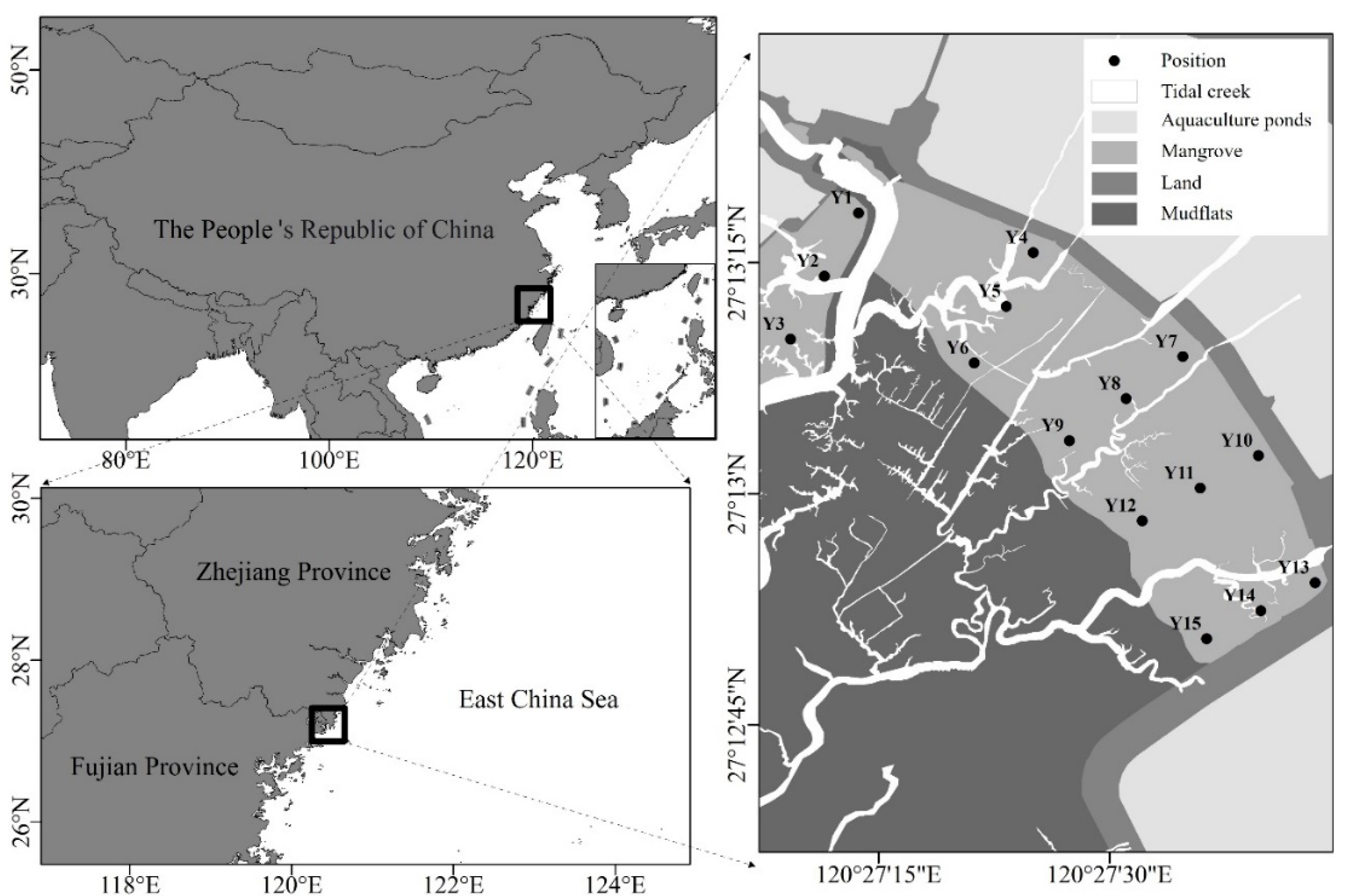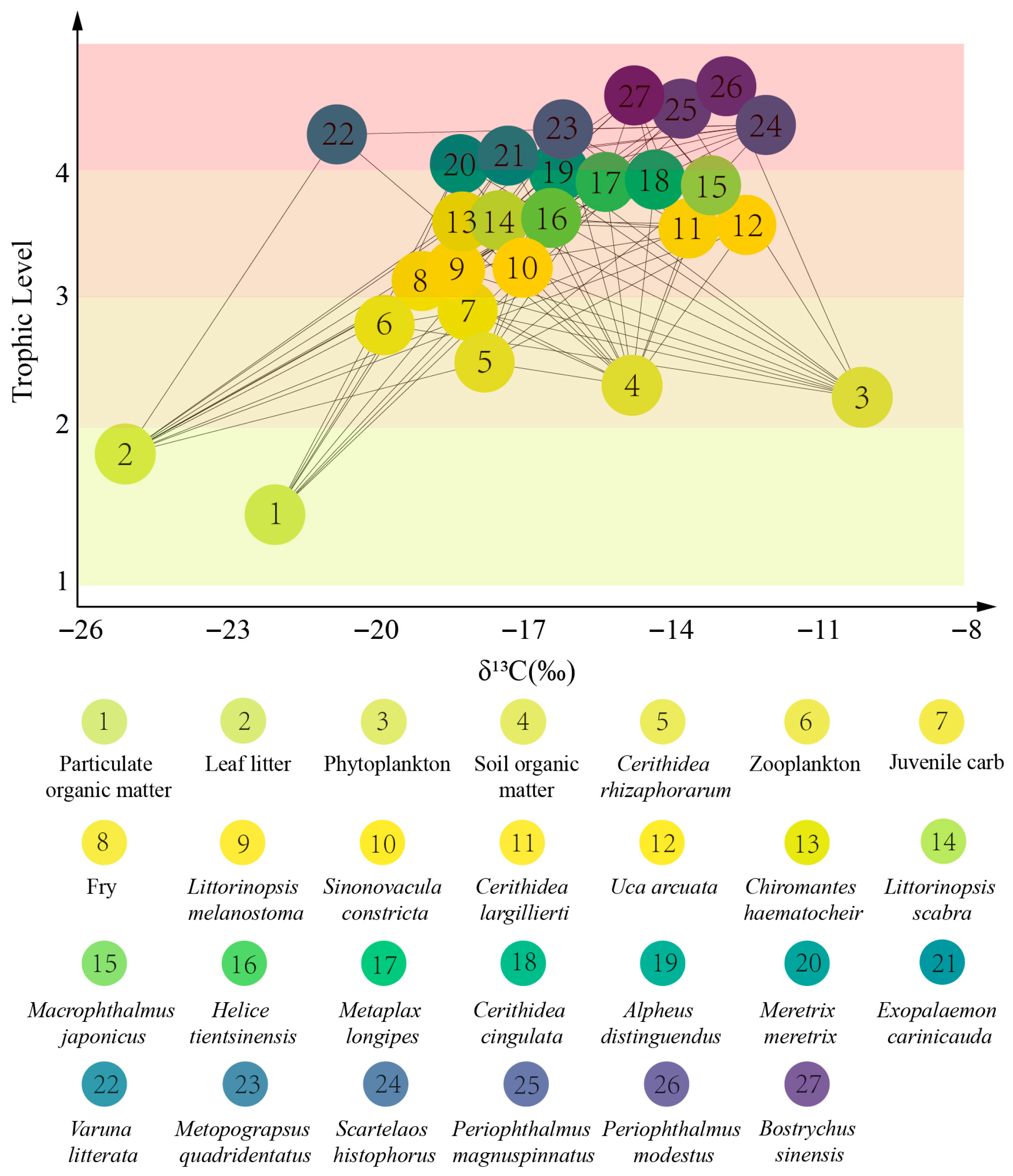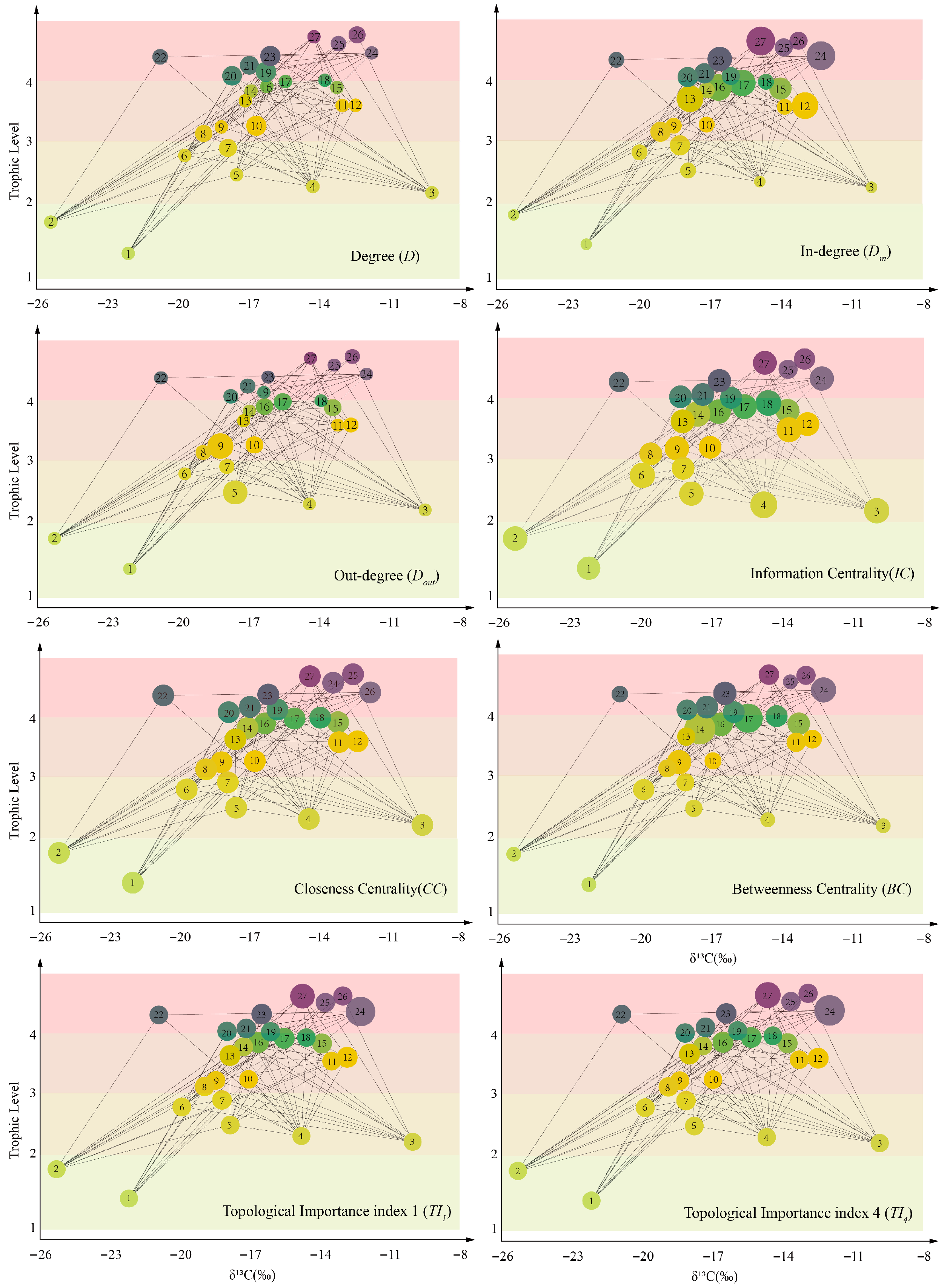Identifying Keystone Species in the Mangrove Benthic Food Web of Yanpu Bay: Integrating Stable Isotope and Network Analysis Approaches
Abstract
1. Introduction
2. Materials and Methods
2.1. Study Area
2.2. Sample Collection
2.3. Stable Isotope Analysis
2.4. Diet Analysis
2.5. Ecological Network Analysis
3. Results
3.1. Food Web Structure
3.2. Centrality and Topological Importance Indices
3.3. Keystone Indices
3.4. Key Player Problem Indices
4. Discussion
4.1. Diet Determination
4.2. Keystone Species Identification Method Selection
5. Conclusions
Author Contributions
Funding
Institutional Review Board Statement
Data Availability Statement
Conflicts of Interest
References
- Navia, A.F.; Cruz-Escalona, V.H.; Giraldo, A.; Barausse, A. The structure of a marine tropical food web, and its implications for ecosystem-based fisheries management. Ecol. Model. 2016, 328, 23–33. [Google Scholar] [CrossRef]
- Schiel, D.R.; Foster, M.S. The Biology and Ecology of Giant Kelp Forests; University of California Press: Berkeley, CA, USA, 2015. [Google Scholar]
- Martínez-Estévez, L.; Balvanera, P.; Pacheco, J.; Ceballos, G. Prairie dog decline reduces the supply of ecosystem services and leads to desertification of semiarid grasslands. PLoS ONE 2013, 8, e75229. [Google Scholar]
- Bhowmik, A.K.; Padmanaban, R.; Cabral, P.; Romeiras, M.M. Global mangrove deforestation and its interacting social-ecological drivers: A systematic review and synthesis. Sustainability 2022, 14, 4433. [Google Scholar] [CrossRef]
- Segaran, T.C.; Azra, M.N.; Lananan, F.; Burlakovs, J.; Vincevica-Gaile, Z.; Rudovica, V.; Grinfelde, I.; Rahim, N.H.; Satyanarayana, B. Map** the link between climate change and mangrove forest: A global overview of the literature. Forests 2023, 14, 421. [Google Scholar] [CrossRef]
- Yang, T.; Shan, X.; Jin, X.; Chen, Y.; Teng, G.; Wei, X. Long-term changes in keystone species in fish community in spring in Laizhou Bay. Prog. Fish. Sci. 2018, 39, 1–11. [Google Scholar]
- Valls, A.; Coll, M.; Christensen, V. Keystone species: Toward an operational concept for marine biodiversity conservation. Ecol. Monogr. 2015, 85, 29–47. [Google Scholar] [CrossRef]
- Mills, L.S.; Soulé, M.E.; Doak, D.F. The keystone-species concept in ecology and conservation. BioScience 1993, 43, 219–224. [Google Scholar] [CrossRef]
- Libralato, S.; Christensen, V.; Pauly, D. A method for identifying keystone species in food web models. Ecol. Model. 2006, 195, 153–171. [Google Scholar] [CrossRef]
- Paine, R.T. Food web complexity and species diversity. Am. Nat. 1966, 100, 65–75. [Google Scholar] [CrossRef]
- Wootton, J.T.; Power, M.E.; Paine, R.T.; Pfister, C.A. Effects of productivity, consumers, competitors, and El Nino events on food chain patterns in a rocky intertidal community. Proc. Natl. Acad. Sci. USA 1996, 93, 13855–13858. [Google Scholar]
- Wootton, J.T. Predicting direct and indirect effects: An integrated approach using experiments and path analysis. Ecology 1994, 75, 151–165. [Google Scholar] [CrossRef]
- Paine, R.T. Food-web analysis through field measurement of per capita interaction strength. Nature 1992, 355, 73–75. [Google Scholar] [CrossRef]
- Power, M.E.; Tilman, D.; Estes, J.A.; Menge, B.A.; Bond, W.J.; Mills, L.S.; Daily, G.; Castilla, J.C.; Lubchenco, J.; Paine, R.T. Challenges in the quest for keystones: Identifying keystone species is difficult—But essential to understanding how loss of species will affect ecosystems. BioScience 1996, 46, 609–620. [Google Scholar] [CrossRef]
- Hurlbert, S.H. Functional importance vs keystoneness: Reformulating some questions in theoretical biocenology. Aust. J. Ecol. 1997, 22, 369–382. [Google Scholar] [CrossRef]
- Zhou, X.; Wang, Q.; Chun, X. Research and Application of Keystone Species, Umbrella Species and Flagship Species in the Field of Conservation Biology. Terr. Ecosyst. Conserv. 2023, 3, 88–96. [Google Scholar]
- Paine, R.T. A note on trophic complexity and community stability. Am. Nat. 1969, 103, 91–93. [Google Scholar] [CrossRef]
- Yeaton, R.I. Porcupines, fires and the dynamics of the tree layer of the Burkea africana savanna. J. Ecol. 1988, 76, 1017–1029. [Google Scholar] [CrossRef]
- Khanina, L. Determining Keystone Species. Conserv. Ecol. 1998, 2, R2. [Google Scholar] [CrossRef]
- Jordán, F.; Takács-Sánta, A.; Molnar, I. A reliability theoretical quest for keystones. Oikos 1999, 1, 453–462. [Google Scholar] [CrossRef]
- Móréh, Á.; Endrédi, A.; Jordán, F. Additivity of pairwise perturbations in food webs: Topological effects. J. Theor. Biol. 2018, 448, 112–121. [Google Scholar] [CrossRef] [PubMed]
- Berry, D.; Widder, S. Deciphering microbial interactions and detecting keystone species with co-occurrence networks. Front. Microbiol. 2014, 5, 219. [Google Scholar] [CrossRef]
- Xing, M.; Wang, Q.; Li, X.; Li, Y.; Zhou, X. Selection of keystone species based on stable carbon and nitrogen isotopes to construct a typical food web on the shore of Xingkai Lake, China. Ecol. Indic. 2021, 132, 108263. [Google Scholar] [CrossRef]
- Wang, Y.; Kindong, R.; Gao, C.; Wang, J. Identification of keystone species in ecological communities in the East China Sea. Fishes 2023, 8, 224. [Google Scholar] [CrossRef]
- Vorsatz, L.D.; Pattrick, P.; Porri, F. Quantifying the in situ 3-dimensional structural complexity of mangrove tree root systems: Biotic and abiotic implications at the microhabitat scale. Ecol. Indic. 2021, 121, 107154. [Google Scholar] [CrossRef]
- Zhao, Y.; Yang, T.; Shan, X.; Jin, X.; Teng, G.; Wei, C. Stable isotope analysis of food web structure and the contribution of carbon sources in the sea adjacent to the Miaodao Archipelago (China). Fishes 2022, 7, 32. [Google Scholar] [CrossRef]
- Hu, C.; Liu, Y.; Fang, X.; Zhou, Z.; Yu, Y.; Sun, Y.; Shui, B. Assessing heavy metal pollution in sediments from the northern margin of Chinese mangrove areas: Sources, ecological risks, and health impacts. Mar. Pollut. Bull. 2024, 200, 116069. [Google Scholar] [CrossRef] [PubMed]
- Hu, C.; Ma, Y.; Liu, Y.; Wang, J.; Li, B.; Sun, Y.; Shui, B. Trophodynamics and potential health risk assessment of heavy metals in the mangrove food web in Yanpu Bay, China. Sci. Total Environ. 2024, 920, 171028. [Google Scholar] [CrossRef]
- Rossi, L.; Sporta Caputi, S.; Calizza, E.; Careddu, G.; Oliverio, M.; Schiaparelli, S.; Costantini, M.L. Antarctic food web architecture under varying dynamics of sea ice cover. Sci. Rep. 2019, 9, 12454. [Google Scholar] [CrossRef] [PubMed]
- Caputi, S.S.; Careddu, G.; Calizza, E.; Fiorentino, F.; Maccapan, D.; Rossi, L.; Costantini, M.L. Seasonal food web dynamics in the Antarctic benthos of Tethys Bay (Ross Sea): Implications for biodiversity persistence under different seasonal sea-ice coverage. Front. Mar. Sci. 2020, 7, 594454. [Google Scholar] [CrossRef]
- Smith, J.A.; Mazumder, D.; Suthers, I.M.; Taylor, M.D. To fit or not to fit: Evaluating stable isotope mixing models using simulated mixing polygons. Methods Ecol. Evol. 2013, 4, 612–618. [Google Scholar] [CrossRef]
- Estrada, E.; Fox, M.; Higham, D.J.; Oppo, G.L. (Eds.) Network Science: Complexity in Nature and Technology; Springer Science & Business Media: Berlin/Heidelberg, Germany, 2010. [Google Scholar]
- Stephenson, K.; Zelen, M. Rethinking centrality: Methods and examples. Soc. Netw. 1989, 11, 1–37. [Google Scholar]
- Okamoto, K.; Chen, W.; Li, X.Y. Ranking of closeness centrality for large-scale social networks. In International Workshop on Frontiers in Algorithmics; Springer: Berlin/Heidelberg, Germany, 2008; pp. 186–195. [Google Scholar]
- Freeman, L.C. Centrality in social networks conceptual clarification. Soc. Netw. 1978, 1, 215–239. [Google Scholar]
- Jordán, F.; Liu, W.C.; Davis, A.J. Topological keystone species: Measures of positional importance in food webs. Oikos 2006, 112, 535–546. [Google Scholar] [CrossRef]
- Borgatti, S.P. Identifying sets of key players in a social network. Comput. Math. Organ. Theory 2006, 12, 21–34. [Google Scholar] [CrossRef]
- Capocefalo, D.; Pereira, J.; Mazza, T.; Jordán, F. Food web topology and nested keystone species complexes. Complexity 2018, 2018, 1979214. [Google Scholar] [CrossRef]
- Muro-Torres, V.M.; Amezcua, F.; Soto-Jiménez, M.; Balart, E.F.; Serviere-Zaragoza, E.; Green, L.; Rajnohova, J. Primary sources and food web structure of a tropical wetland with high density of mangrove forest. Water 2020, 12, 3105. [Google Scholar] [CrossRef]
- McCallister, S.L.; Bauer, J.E.; Cherrier, J.E.; Ducklow, H.W. Assessing sources and ages of organic matter supporting river and estuarine bacterial production: A multiple-isotope (Δ14C, 㬔C, and δ15N) approach. Limnol. Oceanogr. 2004, 49, 1687–1702. [Google Scholar]
- Phillips, D.L. Mixing models in analyses of diet using multiple stable isotopes: A critique. Oecologia 2001, 127, 166–170. [Google Scholar] [CrossRef]
- Akbari Noghabi, N.; Shojaei, M.G.; Farahani, M.M.; Weigt, M. Stable isotopes reveal the food sources of benthic macroinvertebrates in the arid mangrove ecosystem of the Persian Gulf. Estuaries Coasts 2022, 45, 2241–2253. [Google Scholar] [CrossRef]
- Phillips, D.L.; Gregg, J.W. Source partitioning using stable isotopes: Coping with too many sources. Oecologia 2003, 136, 261–269. [Google Scholar] [CrossRef] [PubMed]
- Yeakel, J.D.; Bhat, U.; Elliott Smith, E.A.; Newsome, S.D. Exploring the isotopic niche: Isotopic variance, physiological incorporation, and the temporal dynamics of foraging. Front. Ecol. Evol. 2016, 4, 1. [Google Scholar] [CrossRef]
- Yang, M.L.; Gao, T.W.; Xing, Y.Z.; Lu, Y.Z.; Nong, Y.; Liu, W.A. Study on the food source of mangrove macrobenthos in Lianzhou Bay. Guangxi Sci. 2017, 24, 490–497. [Google Scholar]
- Chen, Q.; Yu, Z.; Wang, M. Effects of Spartina alterniflora invasion on macrobenthic faunal community in different habitats of a mangrove wetland in Zhanjiang, South China. Reg. Stud. Mar. Sci. 2023, 66, 103148. [Google Scholar] [CrossRef]
- Bui, T.H.; Lee, S.Y. Does ‘you are what you eat’ apply to mangrove grapsid crabs? PLoS ONE 2014, 9, e89074. [Google Scholar]
- Sandoval, L.A.; Mancera-Pineda, J.E.; Leal-Flórez, J.; Blanco-Libreros, J.F.; Delgado-Huertas, A. Mangrove carbon sustains artisanal fish and other estuarine consumers in a major mangrove area of the southern Caribbean Sea. Mar. Ecol. Prog. Ser. 2022, 681, 21–35. [Google Scholar] [CrossRef]
- Kristensen, E.; Bouillon, S.; Dittmar, T.; Marchand, C. Organic carbon dynamics in mangrove ecosystems: A review. Aquat. Bot. 2008, 89, 201–219. [Google Scholar] [CrossRef]
- Odum, W.E.; Heald, E.J. The detritus-based food web of an estuarine mangrove community. In Estuarine Research: Chemistry, Biology, and the Estuarine System; Academic Press: Cambridge, MA, USA, 1975; p. 265. [Google Scholar]
- Zhao, Y.; Shan, X. Topological structure and keystone species of bottom fishery communities in the sea adjacent to Miaodao Archipelago. Acta Hydrobiol. Sin. 2023, 47, 1464–1475. [Google Scholar]
- Ren, K.; Xu, D.; Ren, L.; Zhao, D. Using a topological approach to identify keystone species of fish in eutrophic lake ecosystems: A case of Zhushan Bay, Taihu Lake. Fish. Manag. Ecol. 2023, 30, 89–98. [Google Scholar] [CrossRef]
- Pereira, J.M.; Krüger, L.; Oliveira, N.; Meirinho, A.; Silva, A.; Ramos, J.A.; Paiva, V.H. Using a multi-model ensemble forecasting approach to identify key marine protected areas for seabirds in the Portuguese coast. Ocean Coast. Manag. 2018, 153, 98–107. [Google Scholar] [CrossRef]
- Alfaro, A.C. Diet of Littoraria scabra, while vertically migrating on mangrove trees: Gut content, fatty acid, and stable isotope analyses. Estuar. Coast. Shelf Sci. 2008, 79, 718–726. [Google Scholar] [CrossRef]
- Gasalla, M.A.; Rodrigues, A.R.; Postuma, F.A. The trophic role of the squid Loligo plei as a keystone species in the South Brazil Bight ecosystem. ICES J. Mar. Sci. 2010, 67, 1413–1424. [Google Scholar] [CrossRef]
- Alfaro, A.C. Migration and trail affinity of snails, Littoraria scabra, on mangrove trees of Nananu-i-ra, Fiji Islands. Mar. Freshw. Behav. Physiol. 2007, 40, 247–255. [Google Scholar] [CrossRef]
- Sala, N.M.; Bertness, M.D.; Silliman, B.R. The dynamics of bottom–up and top–down control in a New England salt marsh. Oikos 2008, 117, 1050–1056. [Google Scholar] [CrossRef]
- Graham, J.B. (Ed.) Air-Breathing Fishes: Evolution, Diversity, and Adaptation; Elsevier: Amsterdam, The Netherlands, 1997. [Google Scholar]
- Priyandayani, L.P.; Hendrawan, I.G.; Karim, W. Kelimpahan dan Keanekaragaman Polychaeta pada jenis mangrove yang berbeda di Tahura Ngurah Rai. J. Mar. Aquat. Sci. 2018, 4, 171–178. [Google Scholar] [CrossRef]
- Wang, S.C.; Yang, R.; Gao, C.X.; Han, D.Y.; Ye, S. Keystone species of fish community in the offshore waters of southern Zhejiang: Insight from ecological network. J. Fish. Sci. China 2022, 29, 118–129. [Google Scholar]
- Piraino, S.; Fanelli, G.; Boero, F. Variability of species’ roles in marine communities: Change of paradigms for conservation priorities. Mar. Biol. 2002, 140, 1067–1074. [Google Scholar] [CrossRef]
- Avolio, M.L.; Forrestel, E.J.; Chang, C.C.; La Pierre, K.J.; Burghardt, K.T.; Smith, M.D. Demystifying dominant species. New Phytol. 2019, 223, 1106–1126. [Google Scholar] [CrossRef]
- Chen, P.; Zhang, Y.; Zhu, X.; Lu, C. Distribution of crabs along a habitat gradient on the Yellow Sea coast after Spartina alterniflora invasion. PeerJ 2019, 7, e6775. [Google Scholar] [CrossRef]
- Vahidi, F.; Fatemi, S.M.; Danehkar, A.; Mashinchian Moradi, A.; Mousavi Nadushan, R. Patterns of mollusks (Bivalvia and Gastropoda) distribution in three different zones of Harra Biosphere Reserve, the Persian Gulf, Iran. Iran. J. Fish. Sci. 2021, 20, 1336–1353. [Google Scholar]
- Fang, X.; Chen, W.; Hu, C.; Zhang, K.; Zhou, Z.; Zhang, L.; Shui, B. Contributions of rare and common species to the species diversity of the mangrove macrobenthic community in Aojiang Estuary. J. Fish. China 2024, 48, 089312. [Google Scholar]
- Hunter, M.D.; Price, P.W. Playing chutes and ladders: Heterogeneity and the relative roles of bottom-up and top-down forces in natural communities. Ecology 1992, 1, 724–732. [Google Scholar] [CrossRef]




| k | Filtered Out Nodes | |||||
|---|---|---|---|---|---|---|
| Key Player Problem-1 | 1 | Soil organic matter | F = 0.07 | |||
| 2 | Soil organic matter | Phytoplankton | F = 0.08 | |||
| 3 | Particulate organic matter | Phytoplankton | Zooplankton | F = 0.16 | ||
| 4 | Phytoplankton | Soil organic matter | S. histophorus | B. sinensis | F = 0.55 | |
| 1 | Soil organic matter | DF = 0.03 | ||||
| 2 | Soil organic matter | Phytoplankton | DF = 0.49 | |||
| 3 | Particulate organic matter | Phytoplankton | Zooplankton | DF = 0.52 | ||
| 4 | Phytoplankton | Soil organic matter | S. histophorus | B. sinensis | DF = 0.67 | |
| Key Player Problem-2 | 1 | Soil organic matter | DR = 77.8% | |||
| 2 | Soil organic matter | Phytoplankton | DR = 92.6% | |||
| 3 | Soil organic matter | Zooplankton | M. longipes | DR = 100% | ||
| 4 | Soil organic matter | Zooplankton | Meretrix meretrix | B. sinensis | DR = 100% | |
Disclaimer/Publisher’s Note: The statements, opinions and data contained in all publications are solely those of the individual author(s) and contributor(s) and not of MDPI and/or the editor(s). MDPI and/or the editor(s) disclaim responsibility for any injury to people or property resulting from any ideas, methods, instructions or products referred to in the content. |
© 2025 by the authors. Licensee MDPI, Basel, Switzerland. This article is an open access article distributed under the terms and conditions of the Creative Commons Attribution (CC BY) license (https://creativecommons.org/licenses/by/4.0/).
Share and Cite
Hu, C.; Qu, Y.; Fang, X.; Xu, M.; Feng, J.; Shi, M.; Wang, J.; Shui, B. Identifying Keystone Species in the Mangrove Benthic Food Web of Yanpu Bay: Integrating Stable Isotope and Network Analysis Approaches. Diversity 2025, 17, 714. https://doi.org/10.3390/d17100714
Hu C, Qu Y, Fang X, Xu M, Feng J, Shi M, Wang J, Shui B. Identifying Keystone Species in the Mangrove Benthic Food Web of Yanpu Bay: Integrating Stable Isotope and Network Analysis Approaches. Diversity. 2025; 17(10):714. https://doi.org/10.3390/d17100714
Chicago/Turabian StyleHu, Chengye, Yuwei Qu, Xuehe Fang, Minghai Xu, Jiayu Feng, Mengjia Shi, Jing Wang, and Bonian Shui. 2025. "Identifying Keystone Species in the Mangrove Benthic Food Web of Yanpu Bay: Integrating Stable Isotope and Network Analysis Approaches" Diversity 17, no. 10: 714. https://doi.org/10.3390/d17100714
APA StyleHu, C., Qu, Y., Fang, X., Xu, M., Feng, J., Shi, M., Wang, J., & Shui, B. (2025). Identifying Keystone Species in the Mangrove Benthic Food Web of Yanpu Bay: Integrating Stable Isotope and Network Analysis Approaches. Diversity, 17(10), 714. https://doi.org/10.3390/d17100714





